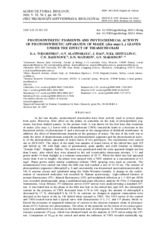Prikaz osnovnih podataka o dokumentu
Photosynthetic pigments and phytochemical activity of photosynthetic apparatus of maize (Zea mays L.) leaves under the effect of thiamethoxam
| dc.creator | Todorenko, D. A. | |
| dc.creator | Slatinskaya, O. V. | |
| dc.creator | Hao, J. | |
| dc.creator | Seifullina, N. Kh. | |
| dc.creator | Radenović, Čedomir | |
| dc.creator | Matorin, D. N. | |
| dc.creator | Maksimov, G. V. | |
| dc.date.accessioned | 2020-07-10T08:12:07Z | |
| dc.date.available | 2020-07-10T08:12:07Z | |
| dc.date.issued | 2020 | |
| dc.identifier.issn | 2412-0324 | |
| dc.identifier.uri | http://rik.mrizp.rs/handle/123456789/794 | |
| dc.description.abstract | In the last decade, neonicotinoid insecticides have been actively used to protect plants from pests. Moreover, their effect on the plants, in particular on the state of photosynthetic pig-ments, has been studied paucity. In the present work, it was shown for the first time that treatment of maize (Zea maysL.) leaves with a thiamethoxam (TMX) insecticide leads to a decrease in the functional activity of photosystem II and a decrease in the energyzation of thylakoid membranes. In addition, the effect of thiamethoxam depends on the genotype of maize. The aim of the work was to study the effect of thiamethoxam pesticide on photosynthetic pigments and the photochemical activi-ty of the photosynthetic apparatus of maize leaves of two genotypes. The experiments were carried out in 2018-2019.The object of the study was samples of maize leaves of the inbred line zppl 225 and hybrid zp 341 with high rates of germination, grain quality and yield (Institut za kukuruz “Zemun Polje”, Belgrade, Serbia). The seeds were germinated until the roots appeared (length not less than 5mm),after which they were planted in the soil (vermiculite:chernozem mixture, 1:1) and grown under 16-hour daylight at a constant temperature of 25 С. When the third trueleaf appeared (more than 4 cm in length), the plants were sprayed with a TMX solution at a concentration of 0.2 mg/l. Plants grown under similar conditions without TMX spraying were used as controls. The measurements were carried out when the fifth true leaf reached a size of 12-14 cm.The content of photosynthetic pigments (chlorophyll a, b and carotenoids) was determined spectrophotometrically in 100% acetone extract and calculated using the Holm-Wetstein formula. A change in the confor-mation of carotenoid molecules was recorded by Raman spectroscopy.Light-induced kinetics of prompt fluorescence (PF), delayed fluorescence (DF) and modulated reflection at = 820 nm (MR) were recorded simultaneously using a multifunctional plant efficiency analyzer M-PEA-2 (Hansatech Instruments, Great Britain). PF induction curves (OJIP curves) were analyzed using a standard JIP-test. It was found that in the phase of the fifth true leaf, in the inbred line zppl 225, the chlorophyll content in the presence of TMX decreased from 0.74 to 0.61 mg/g: the amount of chlorophyll a decreased by 17 %, chlorophyll b by 24 %. In contrast, no changes in pigment composition were detected in the leaves of the zp 341 hybrid when exposed to TMX. The OJIP curves of the control and TMX-treated leaves had a typical curve with characteristic O-J, J-I, and I-P phases, which re-flected the processes of sequential reduction of carriers in the electron transport chain of photosyn-thesis (ETC) between two photosystems. The effect of the pesticide onthe leaves of two maize geno-types was manifested in a decrease in the functional state of photosystem II, determined by the fluo-rescence parameter (PIABS), which was obtained based on the analysis of OJIP curves using the JIP-test. Comparison of PIABSin the control and under the influence of TMX revealed statistically sig- 67nificant (p < 0.05) differences: in the leaves of zppl 225 and zp 341 samples treated with TMX, the PIABSparameter decreased by 29 and 24%, respectively. Changes in the fast phase of delayed fluo-rescence, associated with a decrease in the energyzation of the thylakoid membrane upon exposure to TMX, were detected in the leaves of maize. An analysis of the maximum oxidation and reduction rates of P700 (MR kinetics) indicates a decrease in the acceptor pool on the acceptor side of PSI in zppl 225 leaves when exposed to TMX. It was found that the reaction centers (RCs) of PSI zp 341 showed resistance to TMX (no change in the redox transformations of P700). TMX caused changes in the conformation of carotenoid molecules, but did not change their content in the leaf. The pro-posed combination of methods for prompt fluorescence, delayed fluorescence, modulated reflection at = 820 nm and Raman spectroscopy can be the basis for the formation of an effective technology for the diagnosis of early defects of photosynthetic pigments when pesticides enter an intact plant. | en |
| dc.language.iso | en | sr |
| dc.publisher | Moscow : Russian Academy of Agricultural Sciences | sr |
| dc.relation | Supported financially by Russian Foundation for Basic Research, grant No. 20-04-00465 А | sr |
| dc.rights | openAccess | sr |
| dc.rights.uri | https://creativecommons.org/licenses/by/4.0/ | |
| dc.source | Agricultural biology | sr |
| dc.subject | Zea mays L. | sr |
| dc.subject | pesticides | sr |
| dc.subject | Raman spectroscopy | sr |
| dc.subject | thiamethoxam | sr |
| dc.subject | chlorophyll | sr |
| dc.subject | carotenoids | sr |
| dc.subject | chlorophyll fluorescence | sr |
| dc.title | Photosynthetic pigments and phytochemical activity of photosynthetic apparatus of maize (Zea mays L.) leaves under the effect of thiamethoxam | en |
| dc.type | article | sr |
| dc.rights.license | BY | sr |
| dc.citation.volume | 55 | |
| dc.citation.issue | 1 | |
| dc.citation.spage | 66 | |
| dc.citation.epage | 76 | |
| dc.identifier.doi | 10.15389/agrobiology.2020.1.66eng | |
| dc.identifier.scopus | 2-s2.0-85084539961 | |
| dc.identifier.fulltext | http://rik.mrizp.rs/bitstream/id/4204/2020-Agricultural_Biology-55-1-66-76_1-2020todorenko.pdf | |
| dc.type.version | publishedVersion | sr |


